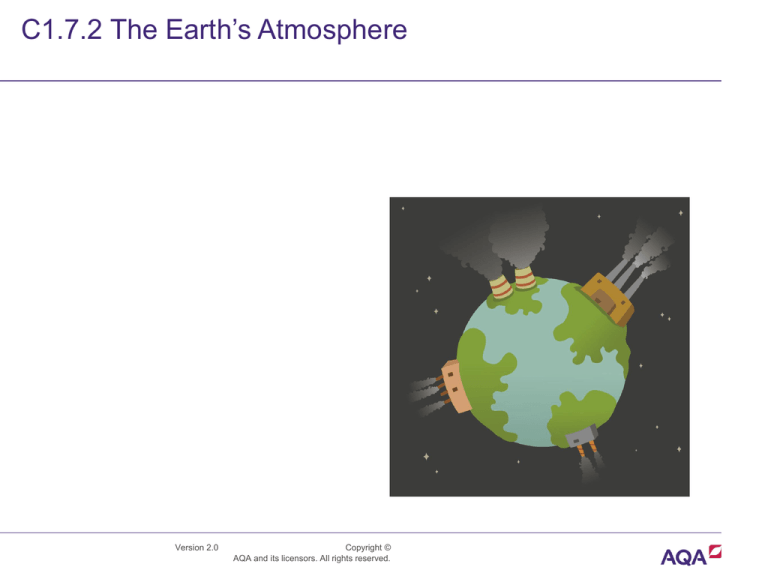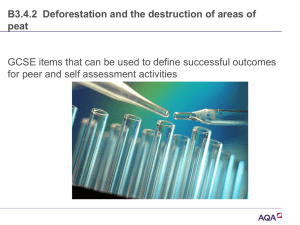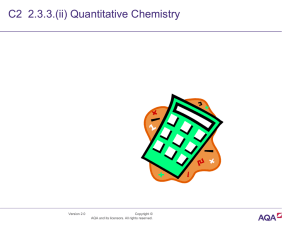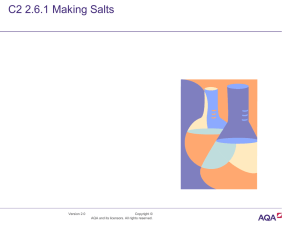
C1.7.2 The Earth’s Atmosphere
Version 2.0
Copyright ©
AQA and its licensors. All rights reserved.
Using Exam pro items to support successful
outcomes
• Learners will be able to test their progress against learning
outcomes using questions from past AQA GCSE examinations
Version 2.0
Copyright © AQA and its
licensors. All rights reserved.
Foundation Tier ( C1 Jun 12 , 2.)
Version 2.0
Copyright © AQA and its
licensors. All rights reserved.
Version 2.0
Copyright © AQA and its
licensors. All rights reserved.
Version 2.0
Copyright © AQA and its
licensors. All rights reserved.
Mark scheme- Foundation
Q
Answer
(a)
A- core
B- mantle
C- crust
(b)
Any 2 from:
• Carbon dioxide dissolves / absorbs in water /
oceans
• Plants/ algae photosynthesise / absorb/ use
carbon dioxide
•
Extra Information
Mark
1
1
1
Marine organisms use ( dissolved) carbon
dioxide to form their shells / skeletons
Or
limestone was formed from shells / skeletons
of marine organisms
allow reacts with water
Accept remains in plants / algae /
marine organisms contain locked
up carbon dioxide / carbon in the
form of fossil fuels
Do not accept plants use carbon
dioxide for respiration
Accept carbon dioxide becomes
locked up in sedimentary rocks /
carbonates / limestone
Precipitation or formation of
insoluble carbonates
Total
Version 2.0
Copyright © AQA and its
licensors. All rights reserved.
2
5
Higher Tier ( C1 Jun 12 , 4.)
Version 2.0
Copyright © AQA and its
licensors. All rights reserved.
Version 2.0
Copyright © AQA and its
licensors. All rights reserved.
Version 2.0
Copyright © AQA and its
licensors. All rights reserved.
Use the information on the last two slides to answer
these questions
Version 2.0
Copyright © AQA and its
licensors. All rights reserved.
Mark scheme- Higher
Q
Answer
(a)
Any 2 from:
•Carbon dioxide dissolves in water /
oceans
•Marine organisms use ( dissolved)
carbon dioxide to form their shells /
skeletons
Or
limestone was formed from the shells
/ skeleton of marine organisms
•Plants ;/ algae photosynthesise / absorb
/ use carbon dioxide
(b)(i)
Extra Information
Because these gases / molecules contain the
elements / atoms in amino acids
Or the gases / they contain carbon, hydrogen
and nitrogen
Version 2.0
Copyright © AQA and its
licensors. All rights reserved.
Mark
2
Accept carbon dioxide becomes
locked up in sedimentary rocks /
carbonates/ limestone
Or
Precipitation or formation of
insoluble carbonates
Accept remains of plants / algae /
marine organisms contain locked
up carbon dioxide / carbon in the
form of fossil fuels
Do not accept plants use carbon
dioxide for respiration
1
Ignore oxygen
Mark scheme- Higher
Q
Answer
(b)(ii)
Any 2 from
• Nobody knows what was in the Earth's
early atmosphere
•
•
There may not have been
( continuous) lightning
Miller and Urey selected only the
gases needed to produce amino acids
Extra Information
Mark
Ignore small scale / timescale
Ignore references to water /
oceans or other theories
2
Accept these gases / hydrogen /
methane/ ammonia may not have
been in the Earth's early
atmosphere
Accept carbon dioxide / nitrogen
may have been in the Earth's
early atmosphere
Accept reference to Venus’
present atmosphere
Total
Version 2.0
Copyright © AQA and its
licensors. All rights reserved.
5





